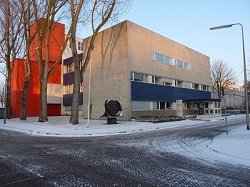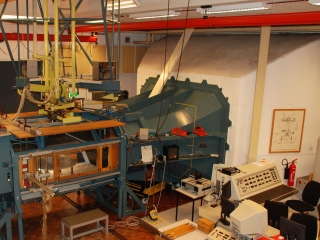The Low speed low turbulence wind tunnel is an atmospheric tunnel of the closed-throat single-return type. The dimensions of the tunnel are enormous, since the fan and engine are on ground level, whereas the settling chamber and the test section are on the second floor. The six-bladed fan is driven by a 525 kW DC motor, giving a maximum test section velocity of about 120 m/s. The maximum Reynoldsnumber for two-dimensional testing is about 3.5 million.
Due to the large contraction ratio of 17.8, the free-stream turbulence level in the test section varies from only 0.015% at 20 m/s to 0.07% at 75 m/s. The corner vanes that rotate the flow in the corners of the tunnel, are equipped with a cooling system to control properties of the flow.
For this wind tunnel 10 interchangeable octagonal test sections of 1.80 m wide, 1.25 m high and 2.60 meters long are available. The usage of the tunnel is therefore efficient, since test setups can be prepared in the tunnel test section while the tunnel is fully operational.
Mechanically actuated turntables flush with the test-section top and bottom wall provide positioning and attachment for two-dimensional or three-dimensional models. The standard wind tunnel testing equipment consists of an electronically read 200 tubes multimanometer with fiber optic cells, a 6-component balance, a 192 ports electronic pressure scanner system and hot wire anemometry and PIV systems. For flow visualization purposes an infra-red camera system is available. Data are recorded using an electronic data acquisition system and are on line reduced using the HP 9000-712 laboratory computer.
Location:

Low Speed Wind Tunnel Laboratory
- +31 15 2786389
-
Cornelis Drebbelweg 3
2628 CM Delft

Overview of the low turbulence wind tunnel with the balance system
Typical research topics
- Research on laminar airfoils for sailplanes and wind turbines
- Boundary layer suction
- Flow control of separation on wing-flap systems
- Propeller and propeller-wing interaction studies
- Winglets and delta wings
- Analysis of road vehicles, including solar cars
- Stability and control of aircraft models
- General wind engineering research on buildings, surface ships, etc.
- Education: Analysis on airfoils, wings and aircraft models with propeller propulsion



